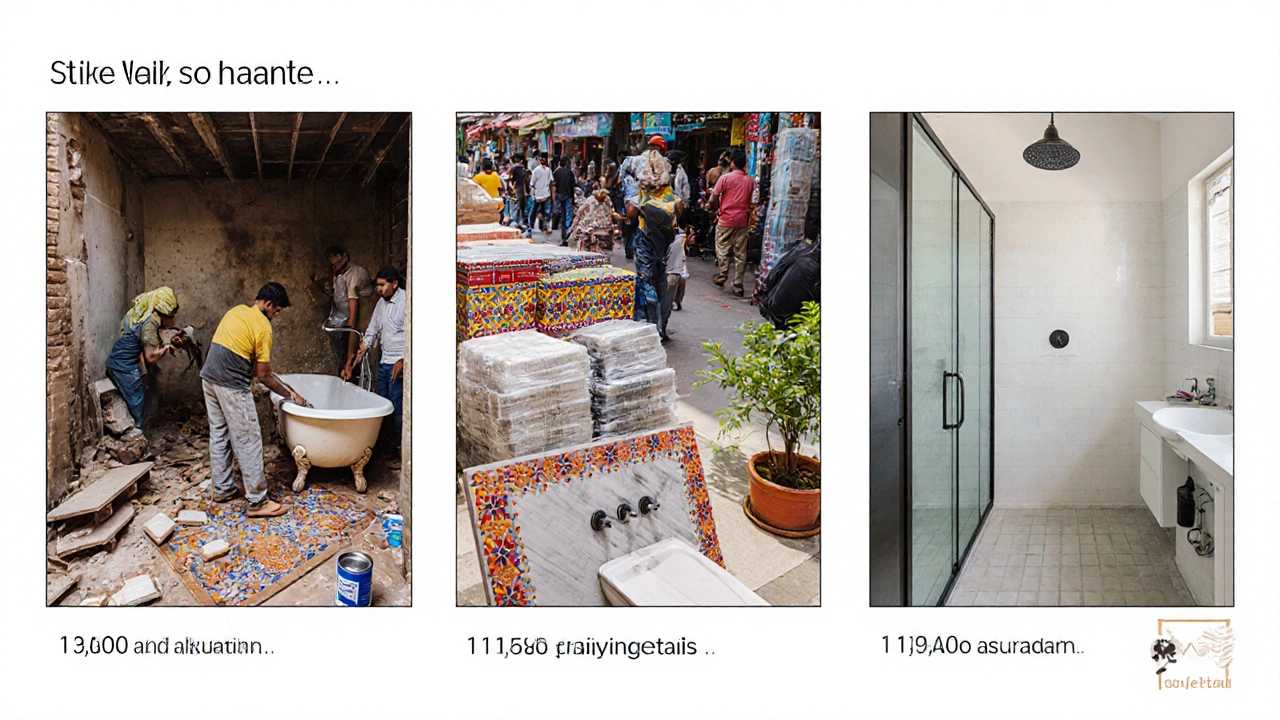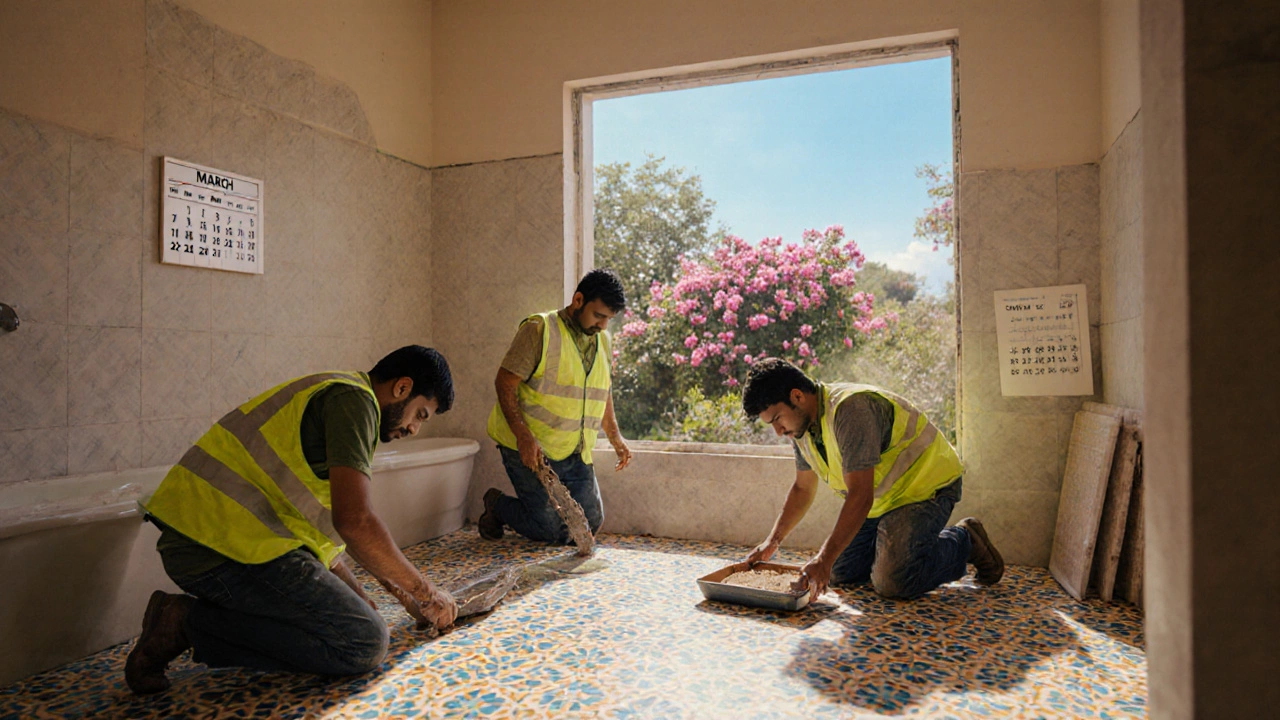Bathroom Remodel Season Planner
Select your preferred season to see key factors affecting your bathroom remodel:
Season Insights
When you hear the phrase Bathroom remodel is a home improvement project that updates fixtures, finishes, and plumbing to improve comfort, value, and style, the first question often is "when should I start?" The timing can affect everything from labor costs to material availability, and even the final look of the space. Below is a quick cheat‑sheet, followed by a deep dive into the seasonal factors that matter most.
TL;DR
- Late spring (October‑December in the Southern Hemisphere) offers mild weather and peak contractor availability.
- Winter months can lower labor rates but may delay work due to rain or limited daylight.
- Avoid school holiday peaks (December‑January) when demand spikes and prices rise.
- Plan for permit approvals early; they often take 2‑3 weeks regardless of season.
- Buy tiles and fixtures in bulk during off‑season sales for up to 30% savings.
Seasonal Weather and Climate Considerations
Weather isn’t just a backdrop; it directly influences how quickly a bathroom can be gutted, tiled, and sealed. In Wellington’s temperate maritime climate, rain is spread throughout the year, but the dry, breezy months of October through February provide the most consistent conditions for plaster and grout to cure properly. If you live in a region with harsher winters, schedule any waterproofing work for the warm months to avoid moisture‑related setbacks.
When Weather refers to atmospheric conditions such as temperature, humidity, and precipitation that affect construction timelines is favorable, you’ll spend less time waiting for walls to dry, meaning the overall project finishes faster and stays on budget.
Contractor Availability and Labor Costs
Seasonal demand shapes the market for skilled Contractor a professional hired to manage demolition, plumbing, electrical, and finishing work in a remodel. In the months of September to November, many contractors are wrapping up winter jobs and looking for new projects, which translates to more flexible schedules and sometimes lower hourly rates. Conversely, December through January is a rush period as families upgrade homes before the market heats up, pushing rates up by 10‑15%.
Tip: secure a written contract and lock in the labor rate before the peak season hits to protect yourself from price hikes.
Permit Timing and Inspection Schedules
Most municipalities require a Permit official authorization from local council to carry out plumbing, electrical, or structural changes before you can start. Permit processing times tend to be steady year‑round, but inspection appointments can be bottlenecked during holiday periods when councils operate on reduced hours.
To keep the project moving, submit your permit application at least three weeks before you plan to break ground. If you’re aiming for a winter start, factor in the possibility of slower inspection turnaround due to shorter daylight hours.

Material Lead Times, Pricing, and Seasonal Sales
Tiles, vanities, and fixtures are often manufactured overseas, so their Lead time the period between placing an order and receiving the product can swing dramatically with global demand. Summer (December‑February) sees a surge in orders for new builds, pushing lead times to 6‑8 weeks. Purchasing during the shoulder seasons-late autumn or early spring-usually shortens delivery to 3‑4 weeks and opens the door to manufacturer promotions.
Seasonal sales are a goldmine. Retailers often discount tile and bath accessories by 20‑30% in March and September to clear inventory for new collections. Pair these discounts with bulk ordering to lock in the best price.
Budget Implications of Seasonal Choices
Your Budget the total amount of money allocated for all labor, materials, permits, and contingencies in a remodel can fluctuate up to 12% based solely on timing. Labor discounts in the off‑peak months, combined with material sales, can shave thousands off a typical $20,000 bathroom remodel.
However, beware of hidden costs: rushing work in bad weather may lead to re‑work, which erodes any savings. Build a 10% contingency to cover unexpected delays, especially if you’re planning a winter project.
Design Trends and Holiday Considerations
While you can install any style at any time, designers often release new bathroom trends in early spring. If you want the latest matte‑black fixtures, bold patterned tiles, or smart shower systems, start planning by August so you can order the newest collections before they hit stores.
On the flip side, if you prefer timeless classics-white subway tile, chrome fixtures-timing matters less. Just avoid starting a remodel right before major holidays (e.g., Christmas, New Year’s) when family gatherings can complicate site access and increase the chance of interruptions.
Step‑by‑Step Timeline for Your Ideal Season
- Choose your target start month (ideal: October‑December).
- Finalize design and create a detailed material list.
- Apply for permits 3‑4 weeks before start date.
- Order tiles, fixtures, and plumbing components during off‑season sales (March or September).
- Confirm contractor schedule and lock in labor rates.
- Prepare the site: protect flooring, set up ventilation, and ensure adequate lighting.
- Begin demolition, followed by plumbing rough‑ins and electrical updates.
- Install insulation, waterproof membranes, and backer boards.
- Tile, grout, and seal-allow 48‑72 hours for curing.
- Fit vanity, fixtures, and trim; schedule final inspection.
- Complete finishing touches and deep clean the space.
Following this sequence aligns with the best seasonal windows, reduces surprises, and keeps your project on track.
Quick Reference Table
| Season | Pros | Cons |
|---|---|---|
| Spring (Sep‑Nov) | Mild weather, high contractor availability, material sales | Potential rain delays in early spring |
| Summer (Dec‑Feb) | Long daylight hours, quick curing | Higher labor demand, longer lead times for imports |
| Autumn (Mar‑May) | Off‑peak pricing, stable weather in many regions | Shorter daylight, possible cooler temperatures |
| Winter (Jun‑Aug) | Lower labor rates, quieter contractor schedules | Moisture concerns, limited ventilation for drying |

Frequently Asked Questions
Can I start a bathroom remodel during the rainy season?
Yes, but choose tasks that are less sensitive to moisture first-like demolition and rough‑in plumbing. Delay tiling and sealing until a stretch of dry days to avoid cracking or mold.
Do permits take longer in summer?
Permit approval time is usually stable year‑round, but council inspection slots may be tighter during holiday periods, so submit early regardless of season.
Is it cheaper to hire a contractor in winter?
Often, yes. Contractors may offer discounts of 5‑15% during low‑demand months, but weigh this against possible weather‑related delays that could extend the project timeline.
How far in advance should I order tiles?
Order at least 6‑8 weeks before the planned installation date. If you’re buying during a sale, add an extra week for stock replenishment.
What’s the biggest mistake homeowners make with timing?
Rushing the project to meet a holiday deadline. Poor weather, rushed permits, and unavailable contractors can lead to costly re‑work. Build a realistic timeline with buffers.

